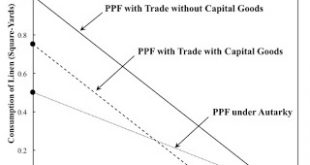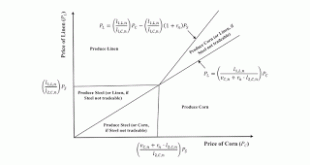1.0 Introduction This is some well-established mathematics. I do not know of any use in economics. 2.0 The Field of Real Numbers I start by taking real numbers R, with binary operations for addition and multiplication, as known. 3.0 A Ring of Polynomials Consider polynomials with coefficients taken from the reals as a formal object: R[X] = { anXn + ... + a1X + a0 | n ≥ 0, coefficients from the reals. } The symbol X is known as an indeterminate. One does not consider it here as a...
Read More »An Opportunity For The Working Class With Increased Markups
A Switch-Point Perturbation Diagram I have a new working paper at SSRN. Abstract: This article presents an analysis based on a comparison of stationary states. With technology and relative markups among industries taken as exogenous, the long-period trade-off between wages and rates of profits is determined. A long-period change in relative markups among industries can create a switch point exhibiting capital-reversing. Around such a switch point, a higher wage is associated with firms...
Read More »Neoliberals, Liberals, Progressives, Social Democrats, and Democratic Socialists
I guess this is a post on current events in the United States. Some articles I have recently found interesting are: Sean Wilentz defends liberals from those further left. Gilad Edelman reacts in the Washington Monthly. Nathan Robinson on the range of ideas connected with socialism. I take it socialists want to work towards a society in which, "The free development of each is the condition for the free development of all" (Karl Marx). The idea is that each person should be able to develop...
Read More »Lack Of Rigor In Mas-Colell, Whinston, And Green
Whether or not the government should intervene in the economy is a false choice. Government and the economy are not too separate and non-intertwined entities. The standard introductory graduate microeconomics textbook now current was written by Mas-Colell, Whinston, and Green. This happens to be from Chapter 15, in the part on the Edgeworth box: "We can now verify a simple but important fact: Any Walrasian equilibrium allocation ... necessarily belongs to the Pareto set... Thus, at any...
Read More »The Loss From Trade With Capital Goods: The Sraffian Bonus Can Be Negative
I have written up this result here Abstract: Paul A. Samuelson extends the Ricardian theory of foreign trade to a model of small open economies in which countries can trade semi-finished capital goods on international markets, as well as trade in produced consumer goods. He argues that this extension provides an additional gain from trade, which he labels the Sraffian bonus. This article demonstrates that trade in consumer and capital goods can result in a loss for an economy, given...
Read More »A Country Worse Off With Trade In Capital Goods
Figure 1: PPFs in Portugal1.0 Introduction This post continues these two posts. I change the model here to have wages advanced, not paid out of the surplus at the end of the year. I here consider an example of a model of stationary states in which two countries can trade in produced commodities to be used for consumption. The countries face given prices on international markets for traded commodities. (They are small open economies, in the jargon.) I take the rate of profits as given in...
Read More »More On Foreign Trade In Consumer And Capital Goods
Figure 1: Rates Of Profits for Specialization in Consumer Goods1.0 Introduction This post is a continuation of this example. How a country specializes in foreign trade depends on distribution. And foreign trade can reduce the consumption basket to be divided among the inhabitants of a country, as compared with autarky. 2.0 Patterns of Specialization Assume that the consumption basket in both countries contains both corn and linen. In a steady state, international prices and the...
Read More »Ideological Innocence Of The Fox News Viewer
1.0 Introduction This post deals with a set of ideas that I find appealing, but contradictory. I know I do not fully understand many of them. Perhaps somebody who understands more can either agree with me that there are contradictions here or point to some way of resolving them. This post is also more about current events than is typical of my posts. 2.0 Ideological Thinking, Ideological Identification, And Party Identification Consider Philip Converse's claim that a mass majority of the...
Read More »Foreign Trade In Capital And Consumer Goods
Figure 1: Specialization In A Single Country1.0 Introduction This post considers how the firms in a small open economy will specialize, given prices on international markets and the domestic rate of profits. The example would only be interesting as part of a larger argument, which I have not yet worked out. 2.0 Technology Consider a small, open economy which has a flow-input, point-output technology for producing two consumption goods, corn and linen. Corn is manufactured from inputs of...
Read More »Can A Nazi Be Rational?
Hilary Putnam has long argued that facts and values, or ends and means, cannot be neatly separated. In 1981 he proposed a thought experiment, I assume not to be of contemporary political relevance: What troubled us earlier was that we did not see how to argue that the hypothetical 'perfectly rational Nazi' had irrational ends. Perhaps the problem is this: that we identified too simply the question of the rationality of the Nazi (as someone who has a world view or views) with the...
Read More » Heterodox
Heterodox




